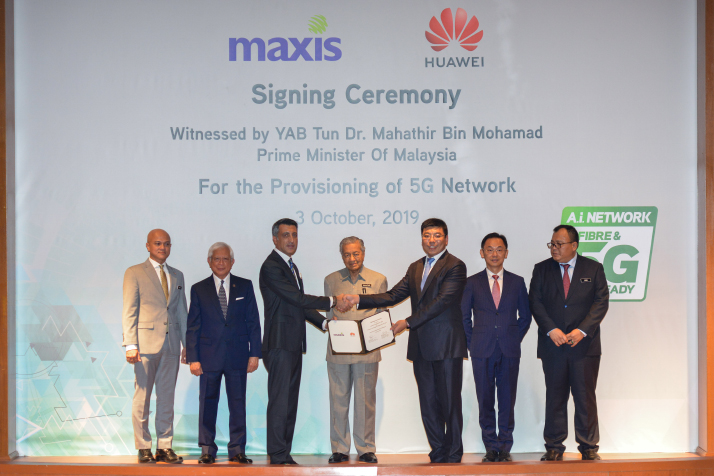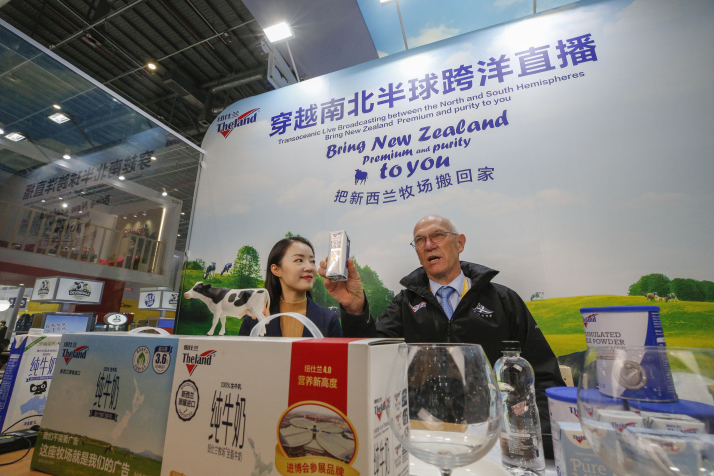| Top 10 World News Stories |
| APEC Putrajaya Vision 2040 Adopted | |
| With the world today undergoing changes unseen in a century, APEC members need to uphold the vision of a community with a shared future in the region | |
|
|
 Executives of Maxis, the largest mobile operator in Malaysia, and Huawei, Chinese 5G technology supplier, sign a 5G network agreement in Kuala Lumpur, Malaysia, on October 3, 2019 (XINHUA)
 The 27th Asia-Pacific Economic Cooperation (APEC) Economic Leaders' Meeting held on November 20 via video link was significant for several reasons. This year is the target date for meeting the second objective of the APEC goals set in 1994. Known as the Bogor Goals after the city in Indonesia where APEC leaders met that year, the objective was to create a free trade and investment system for the developed member economies by 2010, and by 2020 for developing member economies. The 27th Asia-Pacific Economic Cooperation (APEC) Economic Leaders' Meeting held on November 20 via video link was significant for several reasons. This year is the target date for meeting the second objective of the APEC goals set in 1994. Known as the Bogor Goals after the city in Indonesia where APEC leaders met that year, the objective was to create a free trade and investment system for the developed member economies by 2010, and by 2020 for developing member economies.After more than two decades of efforts, APEC has made tremendous progress in achieving the goals, with more free trade and investment between member economies than before. This has helped promote regional economic growth, making the Asia-Pacific the most dynamic area in the world economy. However, 2020 has also witnessed the novel coronavirus disease (COVID-19) pandemic, which has deeply impacted the global economic and political landscape. According to statistics from the Johns Hopkins University in Baltimore, the U.S., by November 20, the day of the APEC economic leaders' meeting, the number of people infected with COVID-19 in the world was about 57 million. More than one third of them, 18 million, were in the 21 member economies of APEC. China was the first to report COVID-19 infections in the world, the U.S. has been hit the hardest, and Russia, Mexico and Peru are among the most severely affected countries. The Pacific Economic Cooperation Council, a Singapore-headquartered network promoting cooperation in the Asia-Pacific, said the APEC region's growth would decline by at least 2.7 percent this year, or, in the worst-case scenario, by 4 percent. This is a situation that didn't happen even after World War II, or even the global financial crisis of 2008. If the members do not take immediate effective measures, they would face economic and social crises in the future. So fighting the pandemic and ensuring economy recovery were the focus of the meeting, and also of the ministerial and senior officials' conventions held prior to it. Based on the assessment of the Bogor Goals, APEC has formulated an ambitious and strategic post-2020 agenda, the APEC Putrajaya Vision 2040, to guide future cooperation between members in building an open, dynamic, resilient and peaceful Asia-Pacific community. In the 2020 Kuala Lumpur Declaration, APEC leaders pledged to stand united to enable the Asia-Pacific region to successfully recover from the COVID-19 pandemic and its economic impacts and navigate toward recovery along the path of strong, balanced, inclusive, sustainable, innovative and secure economic growth. "Our coordinated action and cooperation are more important than ever to overcome the challenges of COVID-19 and realize new and emerging opportunities for prosperity for all," the declaration stated.  An exhibitor promotes New Zealand's dairy products at the Third China International Import Expo in Shanghai on November 7 (XINHUA)
Major issues Stressing "voluntary, non-binding and consensus-building principles," the leaders agreed the new vision will be achieved by pursuing three economic drivers: trade and investment; innovation and digitalization; and strong, balanced, secure, sustainable and inclusive growth. Compared with the Bogor Goals, the 2040 plan does not set quantitative indicators, instead seeking greater development and cooperation. Among the three economic drivers, trade and investment are APEC's strength, innovation and digitalization respond to the trend of the era, and strong, balanced, secure, sustainable and inclusive growth echoes the development vision of APEC since the global financial crisis of 2008. The APEC trade ministers' statement in May also said Asia-Pacific countries would jointly respond to the pandemic, maintain a stable trade and investment environment, and jointly promote economic recovery. So overall, cooperation is still the main theme of APEC. The other issues discussed included trade and investment liberalization and facilitation, mid-term assessment of the APEC interconnection blueprint, the digital economy and the Asia-Pacific Free Trade Area. Socioeconomic issues such as women's empowerment and leadership and shaping an ecosystem conducive to startups and social enterprises were also on the agenda. Besides Vision 2040, other takeaways from the meeting are a workplan for the APEC Internet and Digital Economy Roadmap and establishment of an APEC digital economy virtual institute. The roadmap is a framework created three years ago to facilitate technological and policy exchanges among members and bridge the digital divide in the APEC region. It lays out 11 key areas of work. APEC's discussion on innovation and digitalization this year is a continuation of its work in the digital economy in recent years, and also one of the highlights of this year's work, indicating that innovation and digitalization will occupy a significant position in the post-2020 agenda. China's role China has basically succeeded in controlling and preventing the epidemic, providing experience for other APEC members still unable to do so. Also, the Chinese economy is recovering rapidly. Based on the dual circulation development pattern, where domestic and foreign markets complement and reinforce one another, with the domestic market as the mainstay, the economy is expected to grow by 1.9 percent this year according to the forecast of the International Monetary Fund in October, probably the only major economy to see positive growth in 2020. This will provide an impetus for the economic recovery of other APEC members. China has contributed to the signing of the Regional Comprehensive Economic Partnership (RCEP) on November 15 after eight years of negotiations, and the new trade bloc, the largest in the world, will accelerate the economic integration of East Asia. Besides, President Xi Jinping has announced that China will consider joining the Comprehensive and Progressive Agreement for Trans-Pacific Partnership (CPTPP), another free trade agreement with 11 members in which some RCEP members are involved as well. If that happens, APEC's trade and investment liberalization process will be further promoted and the integration of the regional economy enhanced. It will also mark the United States' decline in leadership as Washington pulled out of the deal preceding CPTPP while China played an important role in bringing the RCEP to fruition despite differences among the first negotiators. China's active participation in regional cooperation has been recognized by other APEC members and beyond. With the world today undergoing changes unseen in a century, APEC members need to uphold the vision of a community with a shared future in the region. For that they should deepen solidarity and expand cooperation to meet common challenges. The author is director of research, China National Committee for Pacific Economic Cooperation (Print Edition Title: APEC's New Goal) Copyedited by Sudeshna Sarkar Comments to yanwei@bjreview.com |
|
||||||||||||||||||||||||||||||
|
